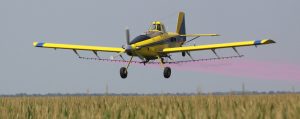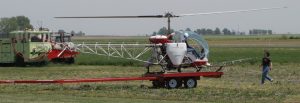Aerial Applications in the USA
The application of pesticides by air, or aerial application, is an efficient and effective means of spraying in variety of situations. Agricultural aircraft are designed and set up specifically for the purpose of making both liquid and dry applications. This article will focus on liquid applications.

Figure 1. An Air Tractor AT-502B making a fungicide application to corn. This aircraft is powered by a turbine engine and has a 500-gallon capacity hopper. Typical application speed would be between 130 and 145 mph.
There are two primary advantages to aerial application over ground application. The first is the lack of crop damage that occurs when an agricultural aircraft is used because the aircraft never comes in direct contact with the crop, whereas equipment can damage the crop during a ground.application, the extent of damage depending on the crop and growth stage. The second advantage is timeliness of application. The speed of agricultural aircraft and their ability to make applications when the ground is too wet for ground applications means that applications can be made in a timelier manner by aerial application. This can be especially important for outbreaks of pests that require large acreages to be treated in a short period of time, or when poor weather conditions have shortened the application window.

Figure 2. A Bell/Texas Helicopter M74A Wasp helicopter with spray system that has two 55 gallon tanks. Typical application speed would be 60 mph.
Aerial applications can be done with both fixed-wing aircraft (Figure 1) and helicopters (Figure 2). Capacities range from 90 gallons to 800 gallons, with a 1,000 gallon aircraft being developed. Common working speeds range from around 50 miles per hour (mph) to around 160 mph. Fixed-wing aircraft have larger hopper capacities and faster working speeds than helicopters. Helicopters can load at the application site using a nurse truck with a landing platform and the slower working speed allows them to treat smaller fields and fields with numerous obstructions more effectively. The most effective aircraft type for any given job depends heavily on the spray application rate, measured in gallons per acre (GPA), the size and layout of the field, the distance from the nearest suitable airfield, and obstruction in and around the application site. According to the Federal Aviation Administration (FAA), there are approximately 3,600 agricultural aircraft in service in the United States. A 2012 survey report by the National Agricultural Aviation Association (NAAA) indicates approximately 87% of the agricultural aircraft fleet in the United States is composed of fixed wing aircraft. Helicopters comprise the remaining 13%.
This is an extract of the full article published in: Outlooks on Pest Management – October 2015 issue.
The full text of this article is available to subscribers of Outlooks on Pest Management.
Non-subcribers may buy & download full text article.
Author: Scott Bretthauer, Extension Specialist, Department of Agricultural and Biological Engineering, University of Illinois at Urbana-Champaign, USA – describes the techniques, technologies, and challenges associated with aerial spraying.
Category: Agriculture










